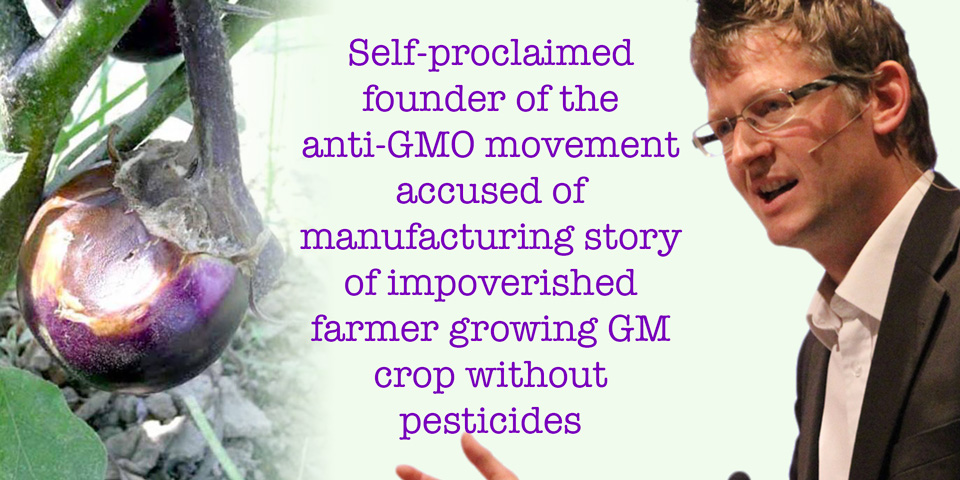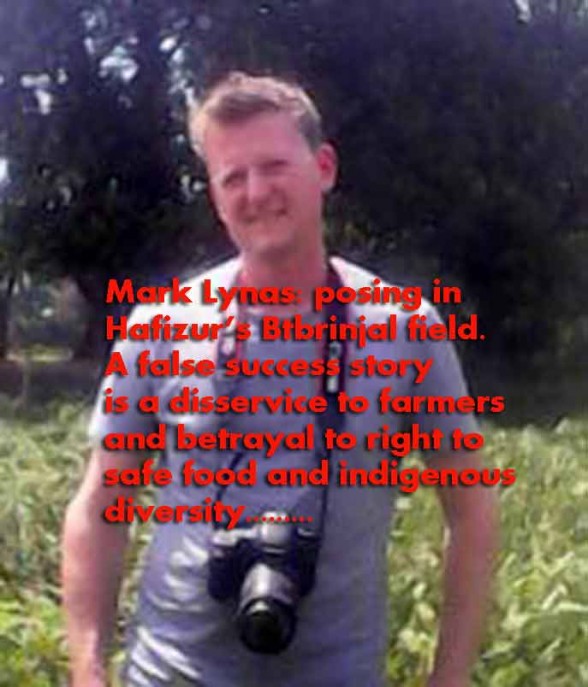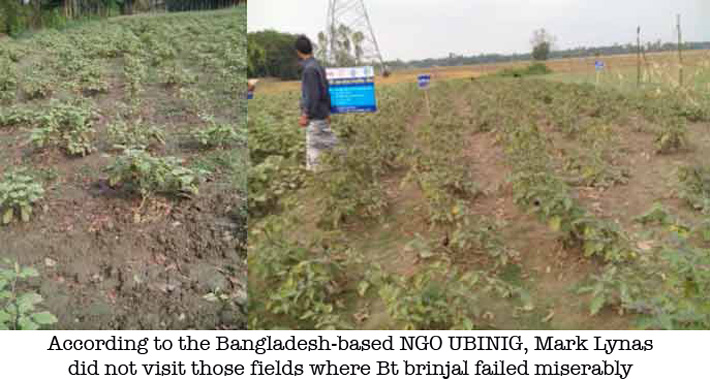
New evidence from Bangladesh raises further questions about the claims made by Mark Lynas, writes Jonathan Matthews
Mark Lynas is rarely out of the news these days. Most of this attention is generated by the remarkable journey he describes: one where he begins as "the first anti-GMO activist in the world" and ends as an avid GMO supporter desperate to make amends for the movement he started.
A recent headline – "Why the founder of the anti-GMO movement converted to the side of science" – perfectly captures the trope of the repentant environmentalist that the media finds so irresistible.
Despite the fact that his claim to being a founding figure in the anti-GMO movement has been roundly condemned as completely untrue by a whole phalanx of (genuinely) leading figures in the environment movement, Lynas just keeps on making it. And no wonder. His remarkable conversion story has won him the favour of the world's richest man, Bill Gates, whose Foundation has set up a position for Lynas at Cornell, as part of the controversial Cornell Alliance for Science. This allows Lynas to do paid promotion of GMOs "to the exclusion of almost everything else". And, as we have seen, his big conversion story is also his calling card with the world's media.
It was very much to the fore in a recent New York Times piece entitled "How I got converted to GMO food". This was taken apart in a series of letters to the NYT, which found fault with almost every aspect of the article.  But now an even more damaging critique has emerged. We reproduce it in full below because it not only casts further doubts on the claims Lynas makes in his article, but on his general credibility.
But now an even more damaging critique has emerged. We reproduce it in full below because it not only casts further doubts on the claims Lynas makes in his article, but on his general credibility.
The centrepiece of his NYT piece was an impoverished Bangladeshi farmer named Mohammed Rahman, whom Lynas says he met "on his meager acre of waterlogged land" where he grew GMO eggplant (Bt brinjal). Lynas declares the crop to have been an incredible success that has enabled the farmer to dispense with the use of pesticides and to make greater profits by selling his crop at a small premium, labelled as insecticide free.
What's happening on this farm, according to Lynas, is "globally significant". And this helps underpin the plea with which this article ends: "We need this technology. We must not let the green movement stand in its way."
But this remarkable success story has been called into serious question by Farida Akhter from a Bangladeshi NGO that has been monitoring the Bt brinjal field trials. Akhter says that having tracked down the farmer that Lynas wrote about, they've discovered almost every element of the Lynas narrative to be either misleading or false.
According to Akhter, far from being a poor farmer that the GM crop is helping to lift out of poverty, as Lynas claims, Hafizur Rahman (his real name) is actually "a Polytechnic graduate" and "well off commercial vegetable farmer". And the story about the GM crop enabling him to dispense with agrochemicals is also, it seems, very far from the truth – multiple chemicals, including pesticides, were used on the crop. The farmer also complained that the Bt brinjal had a "rough surface and gets soft very quickly", unlike the traditional variety which is "shiny and remains fresh for a longer time".
None of this appeared in the Lynas account, which reported nothing but increased profits for the small farmer who now "looked forward to being able to lift his family further out of poverty”.
Akhter also argues that the Lynas narrative serves to distract from the multiple problems many other farmers have been having with the Bt brinjal trials. Similar problems were also seen last year, the first year Bt brinjal was trialled in Bangladesh, culminating in a furious press conference at which farmers complained they had been "fooled" and used as "guinea pigs" for a failed crop, and demanded compensation for the huge losses they said they had incurred.

Mark Lynas, of course, has a well established strategy for dealing with criticism: attack. When we first exposed the truth about his claims to having been a key figure in the anti-GMO movement, he denounced us as liars paid by Big Organic "to do the dirtiest kind of attack jobs" – a claim he subsequently had to apologise for.
If anyone questions his claims about what's going on with GMOs in the developing world, his first line of defence is to assert: "But you haven't been there." When, however, the criticisms come from people in the very countries he's making his claims about, Lynas reverts to calling his critics liars, as well as to suggesting they're really in the pay of outside forces. It's the same line of attack that the Modi government is currently using to try and silence Greenpeace India.
Of course, we are not in Bangladesh and so it is difficult for us to say definitively that the idyllic account of the Bt brinjal trials promoted by Lynas in the NYT is as wildly inaccurate as Farida Akhter says. We do, however, know that Lynas has a record of making claims that subsequently turn out to be poorly evidenced or simply untrue.
We also know whose interests such fictions serve. Just this week an article in the Indian press used the New York Times article by "Mark Lynas, who launched the anti-GMO movement" as part of an attack on "NGO hocus-pocus" and the "environmental extremists" who oppose GMOs.
Lynas is often used in tandem with Patrick Moore, who presents himself as a founder of Greenpeace, even though Greenpeace says this is not true. It was Moore who originally invented the easy narrative of the leading environmentalist who abandoned the green movement to embrace science. He also pioneered fronting for the GMO lobby, working for years with the Biotechnology Industry Organization. Moore even claims to have encouraged the black market use of GM soy in Brazil that eventually forced its legalization. And more recently, he too has been in Bangladesh, where he also visited the Bt brinjal field trials and talked up their importance.
Lynas has played the media with his own variant on Moore's narrative, enabling the GMO lobby to deploy him as a kind of Patrick Moore Mark II – a PR weapon with which to attack environmentalists and NGOs. That's in spite of the fact that Lynas's credentials are even more suspect than those of Moore, who has been called a "liar for hire".
In their attacks, both Moore and Lynas specialise in emotional blackmail, accusing environmentalists of forcing people in developing countries to continue in poverty while humanitarian solutions to their food and energy needs, like GM crops and nuclear power, are readily available. The problem is that these accusations, like Moore's and Lynas's inflated claims of their own importance, are built on fabrications.
—
Turning Bt brinjal failure into a propaganda of success
Farida Akhter
UBINIG, 15 May 2015
http://ubinig.org/index.php/home/showAerticle/76/english
Since the beginning of the Bangladesh government clearance for field cultivation of GM food crop Bt Brinjal, it has been a scandal. The genetically engineered crop failed miserably in the chosen farmers fields of Bangladesh, despite the careful selection and training of the farmers. Promoters of GMO adopted more scandalous options. They refused to review the experiment by the normative standard of strict scientific experiment and the international ethical standard of precautionery principle obligatory for potential hazards from GMOs. Instead the promoters took more aggressive attempts to carry out propaganda based on false claims. The article of Mark Lynas, introduced as a researcher at the Cornell Alliance for Science, published on April 24, 2015 in New York Times is a pathetic example.
The name of the article is essentially self promotional: 'How I got converted to G.M.O food’. The issue is not how some one got converted to GMO, but failure of field trial of Bt brinjal. Sorry to say, we are not convinced that Mark Lynas was converted in a responsible and ethical course strictly abiding by the standard of science and the precaution necessary for GMOs. People living in other parts of the world and who might be affected as producers and consumers is another major concern. Lynas's conversion to GMO makes no sense to the famers and consumers of Bangladesh as they have totally different experience.
The article is fabricated , misleading and lacks evidence. Some responses to the article were published as letter to the Editor on 4 May, 2015. Anna Lappe of Small Planet Institute said “Mark Lynas profile of one farmer in Bangladesh does not represent the facts on the ground about genetically engineered eggplant there. The trials of the new variety of eggplant have actually had very poor results: Genetic engineering did not protect plants from most pests and have led to crop loss and debt for farmers”. Also she revealed that “Mr. Lynas’ Bangladesh visit was organized by the new Cornell Alliance for Science, funded by a $5.6 million grant from the Gates Foundation, that is promoting biotechnology, not dispassionately reviewing the science.”
So we can at best read Mr. Lynas’ claim as advertisement on behalf of the promoters of GMOs who are desperate to introduce genetically modified brinjals to assert technological and commercial control over a huge multi-million dollar local and international market. How Mr. Lynas tried to accomplish this task is interesting.
Mr. Lynas introduced the farmer as Mohammad Rahman (Mr. Rahman) without mentioning his first name, and did not mention the district he belongs to. There are millions of Rahmans; he avoided giving the first name so that his claims can not be objectively checked. It was Hafizur Rahman, not difficult to find out, since we are monitoring the field trial honestly and objectively despite our criticism of GMOs. Lynas mentioned the village name Krishnapur, not the district, which is 60 miles northwest of the capital Dhaka, known as Tangail. I am amazed at this strategy to hide the identity of the farmer, who according to Mr. Lynas ‘has earned profit by cultivating Bt Brinjal’. If Bt Brinjal is so successful why he does not want to give all the details of the farmer, so that every Bangladeshi journalist and even the Anti-GMO campaigners can visit him and gleefully get converted.
Hafizur is a young farmer-cum-technician cultivated Bt Brinjal along with his brother Alhajuddin because he was given the seedlings. They were given to him as a ‘good’ crop. He is a Polytechnic graduate and a well off commercial vegetable farmer known to the Extension Officials of Agriculture department. They offered him training at Bangladesh Agriculture Research Institute (BARI). He did not need to uplift himself further out of poverty only through selling of Bt Brinjal, as claimed by Mark Lynas ‘with increased profits’. To prove his point Mark Lynas depicted a bleak picture with his prejudiced western eyes seeing ‘shirtless kids’ in a summer season as a sign of poverty.
Mark Lynas did not hesitate to make the same typical false claim as the promoters of Bt Brinjal that ‘for the first time this season, he had been able to stop using pesticides’. In his 38 decimal land where he cultivated two varieties of Brinjals Kazla (Bt Brinjal-2) and Nayantara (Bt Brinjal-3); On the contrary, Hafizur prepared the field with bleaching powder for a week and then used chemical fertilizers such as urea, potash, [gy]psum, tri-super phosphate (TSP) etc. He did not use any pesticide for the fruit and shoot borer (FSB) pest, but had to use pesticides against other pest attacks. FSB is not the only main pest; rather it is one of the many. Other pest attacks include insects, diseases and nematodes that inflict serious damage to brinjal crops causing heavy yield losses. Thus, Hafizur’s field was not free from pesticide use at all.
Hafizur Rahman is one of the 108 Bt brinjal farmers who were ‘forced’ into cultivation of Bt Brinjal without giving them proper information. Despite the fact that Rahman is an educated person he does not have any idea about the GM crops and about the health and other possible harms it might have. He sold the Bt Brinjals with no labels. He was not even asked to label the GMOs. He sold Bt Brinjal and ‘non-Bt Brinjals’ together. People know about new brinjal as “Sarkari Begun’ meaning “government” brinjal.
Hafizur was not happy about how the Bt Brinjal looks. It has rough surface and gets soft very quickly while the traditional variety is shiny and remains fresh for a longer time. At least 10% of Bt Brinjal plants were virus attacked.
Hafizur Rahman could easily recall the Mark Lynas. He showed us the picture of American journalist, he took of him in his mobile phone, who brought a “helicopter drone camera’ to take picture of his Btbrinjal fields. He has the picture of that drone camera too. It was quite exciting for him to see that his field was being filmed with such ‘ultra-modern’ camera. He was also interviewed by other international media as well.
Mark Lynas would have seen different picture if he visited other areas such as Pabna, Meherpur, Manikganj etc. where farmers were also pushed to take Bt Brinjal seedlings and did not get good results. Amjat Hossain a first round farmer in Pabna, declined the offer to grow Bt Brinjal again, but his father-in-Law, Ukil Khan has grown this year. The crop condition appeared the same as it was in last season. There are more flowers but yield was very poor. The plants have burnt appearance. According to Amjat, the farmers will incur heavy loss this year also. Ukil uddin received fertilizer and pesticide from the agriculture office. He sold 40 kilos of Bt Brinjal in the market at Tk. 10 per kilo from a land of 15 decimal. He could have earned Tk. 20,000 in the same field with onions. He wondered, “everyone says Bt Brinjal (as fruit) does not have pest attack. If there is no fruit, then where the attack will be? ”
Extensive crop failures were found by journalists in Bangladesh in the newer areas in the second round. Bt brinjal strains were distributed to farmers and grown again in 2015; the crops failed yet again, even more dismally, according to the United News of Bangladesh, which sent a reporter to investigate. Reporter found that the plants have either “died out prematurely or fruited very insignificantly compared to local varieties”. Spot visits to 12 brinjal fields in the districts of Manikganj, Narsingdi and Comilla over the month of February to March 2015 found hardly any living or properly fruiting plants (see “Bt brinjal turns out to be ‘upset case’ for farmers”, New Age 21 March 2015). Reporting of false success of one farmer ignoring others will just backfire because people in the country are getting the real picture through their own reporting, observation and assessment. Farmers themselves are no more interested in getting losses every year.
Bt Brinjal has failed in Bangladesh. An experiment may fail for many reasons. Nevertheless, the desperate attempt to get government permission to commercialise Bt brinjal, after the failed starts in India and the Philippines, has forced Bangladesh to an extremely vulnerable edge. A coercive undemocratic government in power lacking legitimacy coupled with the alarmingly weak regulatory regime with regard to GMOs has put Bangladesh into serious risks of biological pollution and health hazards.










